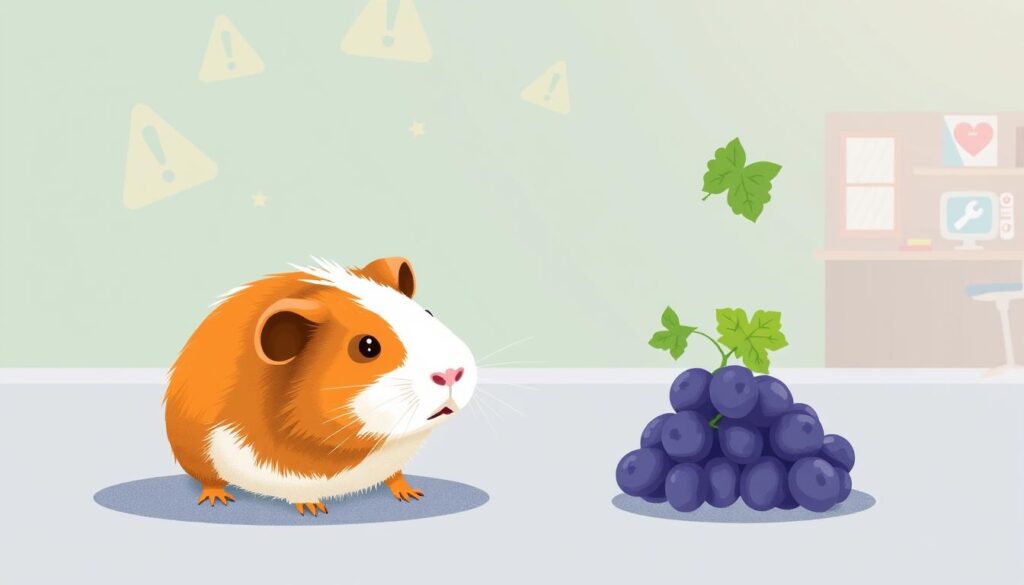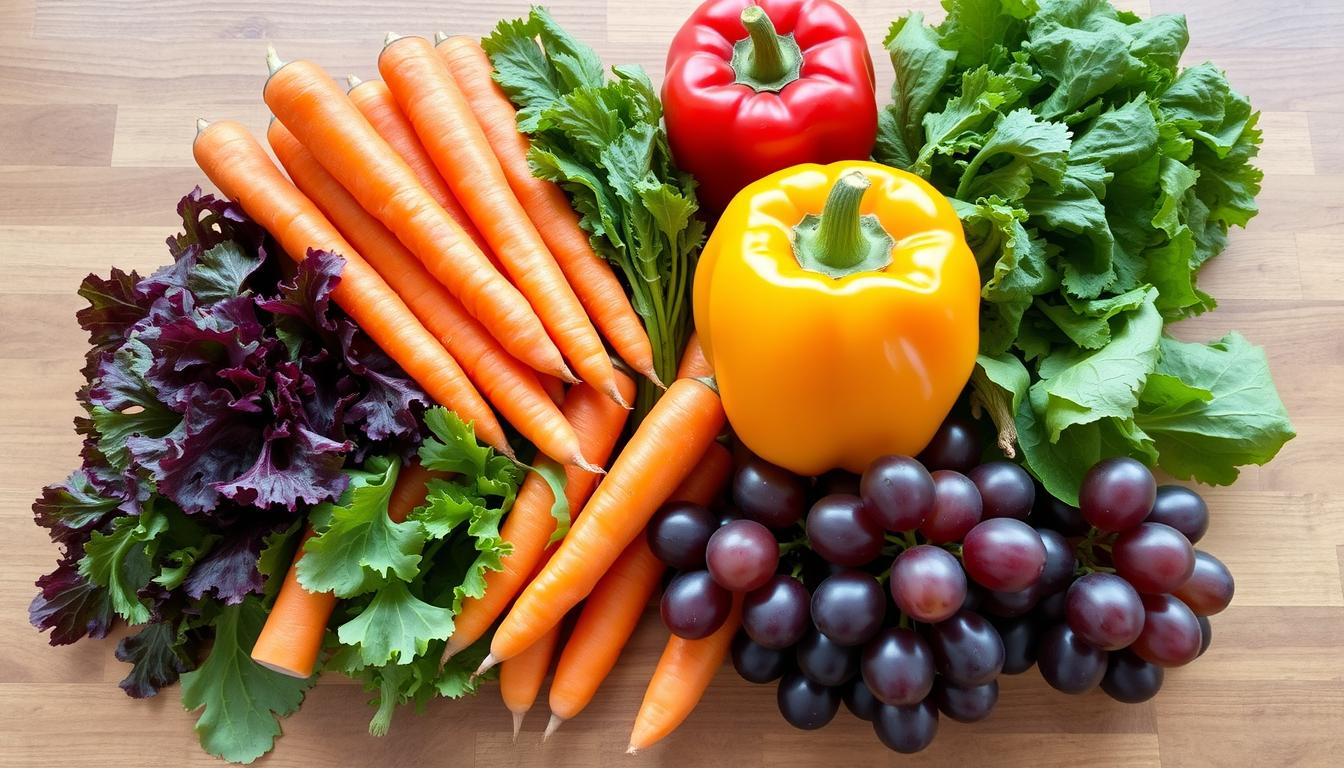I love being a pet owner, especially when it comes to guinea pigs. They are so cute and special. We must make sure they are happy and healthy. Many people wonder, “Can guinea pigs eat grapes?” Let’s explore how grapes can fit into their diet safely.
Table of Contents
Understanding Guinea Pig Basic Nutrition
Guinea pigs need the right food to stay healthy. Their diet should be mostly hay, about 80% of their food. Add fresh veggies, a bit of pellets, and fruits now and then. This mix gives them all the nutrients they need.
Essential Components of Guinea Pig Diet
The key parts of a guinea pig’s diet are:
- Hay: Hay is the base, helping with digestion and teeth health.
- Vegetables: Leafy greens, carrots, and bell peppers are full of vitamins and minerals.
- Pellets: A little bit of pellets can add extra nutrients, but hay and veggies come first.
- Fresh Water: Always have clean water for your guinea pig to drink.
Daily Nutritional Requirements
An adult guinea pig needs about 1 cup of veggies and 2 tablespoons of pellets daily. Don’t forget the hay. Watch how much they eat to keep them at a healthy weight.
Role of Fresh Foods in Diet
Fruits and veggies are key for vitamins and minerals guinea pigs can’t make themselves. While hay, veggies, and pellets are mainstays, fresh foods for guinea pigs can be treats. But, they should only be 10% of their daily food.
Start new foods slowly and watch how your guinea pig reacts. A balanced diet with the right nutrients is key to their health and happiness.
Can Guinea Pigs Eat Grapes
Yes, guinea pigs can have grapes as an occasional treat. But, it’s key to give them in small amounts. Grapes are not harmful to guinea pigs like they are to dogs. They also have antioxidants that can help with health issues.
But, grapes have a lot of natural sugars. So, they should be seen as a special treat, not a main food. It’s wise to introduce grapes slowly and watch your guinea pig for any signs of trouble.
- Grapes are safe for guinea pigs to eat in small amounts
- They provide antioxidants that may offer health benefits
- But grapes are also high in natural sugars, so they should be fed as a treat, not a regular part of the diet
- Start with just a small piece or two and watch for any signs of digestive upset
| Nutrient | Amount per 1 cup of Grapes |
|---|---|
| Vitamin C | 3.2 mg |
| Sugar | 15 g |
| Calories | 104 |
Grapes have good vitamins and minerals, but their sugar is high. So, they should be part of a balanced grapes for guinea pigs diet. With careful feeding, guinea pigs can enjoy grapes as a tasty and healthy treat.
“Grapes are a safe and enjoyable occasional treat for guinea pigs, but they should not make up a significant portion of the diet.”
Nutritional Benefits of Grapes for Guinea Pigs
Grapes can be a good choice for your guinea pig’s diet, but only in small amounts. They have lots of sugar. But, they also have vitamins, minerals, and antioxidants that are good for your pet.
Vitamins and Minerals in Grapes
Grapes are packed with vitamin C, which guinea pigs can’t make on their own. A cup of grapes has about 3.2 mg of vitamin C. This helps meet the 20-25 mg daily need for guinea pigs. They also have potassium, which is key for keeping muscles working right and fluids balanced.
Antioxidant Properties
Grapes are full of antioxidants like quercetin, resveratrol, and polyphenols. These help protect your guinea pig’s cells from harm. This might lower the chance of getting sick.
Hydration Benefits
Grapes are mostly water, which is great for keeping your guinea pig hydrated. This is especially true when it’s hot or they’re very active. Staying hydrated is vital for their health.
Even though grapes have some good stuff, they shouldn’t be a big part of your guinea pig’s diet. Their diet should mainly be hay, vegetables, and a little bit of pellets. It’s important to not overdo it with grapes.
Potential Risks and Health Concerns
Grapes can be good for your guinea pig, but too much is bad. They have a lot of sugar, which can cause obesity, diabetes, and dental problems. These are serious health issues for your furry friend.
Too many grapes can also upset your guinea pig’s stomach, leading to diarrhea. The seeds can be a choking hazard. So, it’s best to remove them or choose seedless grapes.
Raisins, or dried grapes, are even worse. They have too much sugar and can be very harmful. Giving raisins to guinea pigs is a big no-no.
When introducing new foods, like grapes, do it slowly. Watch your guinea pig for any signs of allergies or stomach problems. Always keep an eye on how they react to new foods.
- Grapes can lead to obesity, diabetes, and dental issues in guinea pigs due to their high sugar content.
- Excessive grape consumption may cause gastrointestinal problems like diarrhea.
- Grape seeds pose a choking hazard, so it’s best to remove them or use seedless varieties.
- Raisins (dried grapes) should never be fed to guinea pigs as they are extremely high in sugar.
- Always introduce new foods gradually and watch for signs of allergic reactions or digestive upset.

Remember, grapes are tasty but should be given in small amounts. They should be part of a balanced diet for your guinea pig’s health. Always watch how your pet reacts to new foods to avoid health problems.
Proper Serving Size and Frequency
Feeding your guinea pig the right amount of grapes is crucial. Grapes should be a rare treat, not a main part of their diet. A small grape or half a large one is enough for a serving.
Recommended Portion Sizes
For grapes, a small amount is best. Think of one small grape or half a large one. Serve it 1-2 times a week to keep their diet balanced.
Weekly Feeding Schedule
- Offer grapes as a treat only 1-2 times per week.
- Ensure that grapes make up no more than 5% of your guinea pig’s overall diet.
- Focus on providing a diet rich in hay, fresh vegetables, and high-quality pellets to meet their daily nutritional requirements.
Signs of Overfeeding
Watch how your guinea pig reacts to grapes. Too much can lead to weight gain, diarrhea, or a lack of interest in other foods. If you see these signs, stop giving grapes and talk to your vet.
Keeping your guinea pig healthy means a balanced diet and the right amount of food. By following these tips, you can add grapes to their diet safely. This way, they get all the nutrients they need.
Safe Preparation Methods
When preparing grapes for your guinea pigs, their safety is key. Start by washing the grapes well to remove any harmful chemicals. Choose seedless grapes to avoid choking hazards.
To make grapes safe for your guinea pigs, cut them into halves or quarters. Serve them raw and fresh. Avoid cooked, frozen, dried, or canned grapes as they can change their nutritional value.
- Use a clean, non-tip bowl to serve the grapes to your guinea pigs.
- Discard any uneaten grapes after a few hours to prevent spoilage and ensure your pets’ safety.
By following these safe preparation methods, you can give your guinea pigs the good stuff from grapes. But, always keep pet food safety in mind when preparing fruits for guinea pigs.
| Fruit | Serving Recommendation | Potential Risks |
|---|---|---|
| Grapes | Halves or quarters, 1-2 times per week | High in sugar, can lead to weight gain and dental problems if given in large quantities |
| Bananas | Small slice, 1-2 times per week | High in sugar, can contribute to obesity and diabetes if consumed in excess |
| Oranges | Small wedge, 1-2 times per month | Acidic, can cause mouth sores if offered too frequently |
Always introduce new foods slowly to your guinea pigs. Watch how they react to ensure their safety and happiness.

Different Types of Grapes for Guinea Pigs
Guinea pigs can enjoy many grape varieties, each with its own health benefits. Darker grapes like purple, red, or black have more antioxidants. But, green or white grapes are also safe and nutritious for them.
Red vs. Green Grapes
Both red and green grapes are good for guinea pigs. Red grapes have more antioxidants, like resveratrol, which is good for health. Green grapes, on the other hand, have vitamins and minerals that keep guinea pigs healthy.
Seedless vs. Seeded Grapes
It’s best to give seedless grapes to guinea pigs. Grapes with seeds can be a choking hazard. Wild grapes are okay if they’re free of pesticides and safe for your pet.
Remember, grapes should be given in small amounts because of their sugar. The right amount and a balanced diet will keep your guinea pig happy and healthy.
Integrating Grapes into a Balanced Diet
Grapes can be a tasty and nutritious treat for your guinea pig. But, they should only be a small part of their diet. High-quality hay should make up 70-80% of their intake. Vegetables like leafy greens, bell peppers, and carrots should be 10-15% of their diet, providing important vitamins and minerals.
Fruits, including grapes, should not exceed 5% of their daily calories. When adding grapes to their diet, do it slowly and in small amounts to prevent digestive issues. Mix different fruits and vegetables to keep their diet varied and balanced.
A happy and healthy guinea pig enjoys a varied diet. By adding grapes as an occasional treat, while focusing on hay and fresh veggies, your guinea pig will thrive. This ensures they stay healthy and bring joy to your life.

